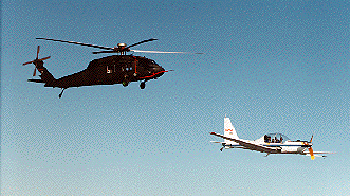In-Flight Rotorcraft Acoustics Program
UH-60 Flight Tests

The UH-60 helicopter in formation with the YO-3A.
A comprehensive series of tests are in progress for the Sikorsky UH-60 Black Hawk helicopter. The series includes flight tests, including tests under the In-Flight Rotorcraft Acoustics Program (IRAP), plus full- and small-scale wind-tunnel testing of the rotors. The IRAP flight tests are described here, with links to descriptions of the wind-tunnel tests. The IRAP tests were a joint effort with the NASA/Army UH-60 Airloads Project, which used a heavily instrumented UH-60A to acquire a wide variety of research data in flight.
The immediate objective of the IRAP tests was to measure blade-vortex interaction (BVI) noise from the UH-60 in flight. These measurements will be compared with similar wind-tunnel measurements in order to better understand BVI noise, with the ultimate goal of learning how to minimize BVI noise from helicopters.
Measurement of UH-60 BVI Noise
During the IRAP tests, the NASA Ames YO-3A fixed-wing aircraft used a wingtip-mounted microphone to acquire BVI noise generated by the UH-60 Airloads helicopter. The simultaneous acquisition of both in-flight acoustic and airloads data will allow the BVI noise to be examined in great detail. Six flights were performed with the YO-3A and UH-60 flying in close formation. The photo above shows a 3/4 side view of the flight formation. The starboard wingtip microphone of the YO-3A was positioned 22 deg below the rotor hub at a rotor azimuth of 150 deg. The distance between the starboard wingtip microphone and the rotor hub was 1.5 rotor diameters (80.5 ft). Target flight conditions included advance ratios from 0.175-0.250, tip Mach numbers of 0.636 and 0.66, rotor thrust coefficients of 0.0058 and 0.0071, and descent rates of 200-900 ft/min.
A subset of these flight conditions match conditions tested previously in the Deutsch-Niederländischer Windkanal (DNW). During the DNW test, acoustic and blade pressure data from a 1:5.73 scale model of the UH-60 rotor were acquired. To complete the acoustic data base of the UH-60 rotor, preparations are underway to test the UH-60 Airloads blades in the NASA Ames 40- by 80-Foot Wind Tunnel using the Large Rotor Test Apparatus (LRTA). Acoustic and blade pressure data will be acquired for conditions matching the flight and DNW tests. Because the rotor was heavily instrumented in flight, the in-flight rotor state can be accurately duplicated in the wind tunnel.
Related Publications:
Kufeld, R., Balough, D. L., Cross, J. L., Studebaker, K. F., Jennison, C. D., and Bousman, W. G. "Flight Testing of the UH-60A Airloads Aircraft." 50th Annual Forum of the American Helicopter Society, Washington, D.C., May 1994.
See also the references page.
Adapted from "Flight and Wind Tunnel Investigations of Blade-Vortex Interaction Noise," in Research and Technology 1994, NASA TM-108858.
Thanks to David Signor and Gloria Yamauchi.
Point of Contact:
C. W. Acree
NASA Ames Research Center
Moffett Field CA 94035-1000